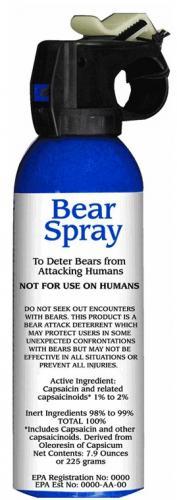Summer backpack trips and hikes are months away, but that doesn't mean you shouldn't be making up gear lists in January or February. And if you're heading to a national park frequented by grizzly or black bears, you'd be wise to look into bear sprays.
According to the National Park Service, bear spray "has proven to be an effective, non-lethal, bear deterrent capable of stopping aggressive behavior in bears."
Not only will the effective use of bear spray save you from an attack, but it also can reduce the number of bears killed in self-defense, the agency notes.
And don't think the only parks you need to carry bear spray in are those with grizzly bears, such as Yellowstone, Grand Teton, or Glacier. Parks with black bear populations, such as Great Smoky Mountains National Park, Yosemite National Park, Sequoia National Park, and Kings Canyon National Park, also are good places to be packing bear spray.
What should you look for when shopping for bear spray? The folks at Yellowstone National Park offer the following pointers:
The proper use of bear spray will reduce human injuries caused by bears as well as the number of grizzly bears killed in self defense. When carrying bear spray, it is important that you select an EPA approved product that is specifically designed to stop aggressive behavior from bears. Personal defense, jogger defense, and law enforcement or military defense spray's may not contain the correct active ingredients or have the proper delivery system to divert or stop a charging or attacking bear.
Selecting A Proper Bear Spray
All bear sprays must be registered with the Environmental Protection Agency. Only use bear spray products that clearly state "for deterring attacks by bears." The EPA registration number is displayed on the front label.
EPA-registered bear sprays, have an active ingredient, clearly shown on the label, of 1 percent to 2 percent Capsaicin and related Capsaicinoids. This active ingredient is what affects the bear's eyes, nose, mouth, throat, and lungs.
EPA-registered bear sprays have a minimum duration of at least 6 seconds or more to compensate for multiple bears; wind; bears that may zigzag, circle, or charge multiple times; and for the hike out after you have stopped a charging bear.
EPA-registered bear sprays shoot a minimum distance of 25 feet or more to reach the bear at a distance sufficient for the bear to react to effects of the active ingredients in time to divert or stop the bear's charge and give the bear time to retreat.
EPA-registered bear sprays have a minimum content of 7.6 oz or 215 grams.
Visitors in bear country should carry a can of bear spray in a quickly accessible fashion. Bear spray should also be readily available in the sleeping, cooking, and toilet areas of backcountry camps.
Be sure the expiration date on your bear spray is current.




Comments
The reason behind the FAA rule that no bear spray may be carried aboard aircraft is simple.
Bear spray is highly pressurized. Some aircraft and their baggage compartments are not. Neither are some baggage compartments on larger aircraft where the passenger cabin is pressurized.
It doesn't take much to imagine what might happen if a bear spray cannister exploded in flight.